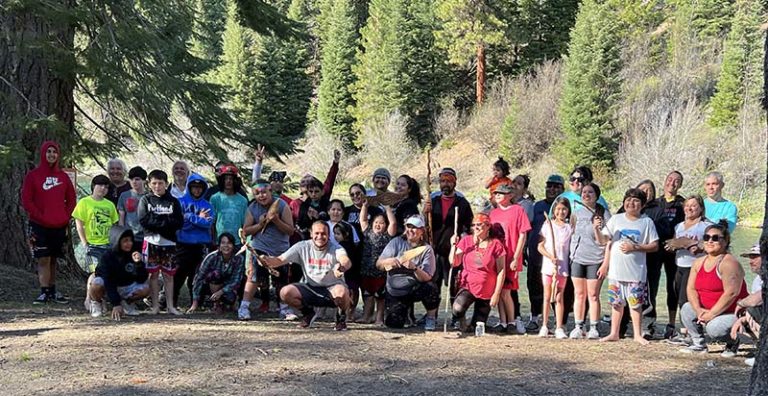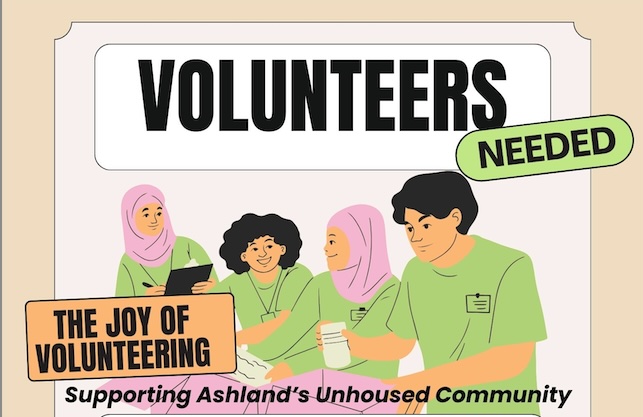It’s impossible to quantify the power of the thousands of footsteps that touched the ground along the Klamath and Trinity Rivers this week, in the 19th annual Klamath Salmon Run. Tribal members from the Yurok, Hoopa, Karuk, Quartz Valley, Klamath Modoc, and Yahooskin Tribes organized runners of all ages to participate in the relay run that carried carved salmon and twisted sticks 320 miles. From Weyhikwew (the mouth) at the ocean near Requa, California to the crystal clear headwaters of the feeder Wood River near Chiloquin, Oregon, runners carried with them the vision of native salmon returning above soon-to-be-removed Klamath Dams.
[soliloquy id=”19318″]
Last Thursday morning, just after sunrise, two carved wooden salmon were submerged in the Pacific ocean to begin their journey upriver. Then the relay began, and runners took turns pacing the lengthy journey. From the mouth to Tuereep (Klamath Glen), past ‘Ernerr’ ‘we-roy (Blue Creek), spanning the south side of the river across rugged terrain all the way to Martin’s Ferry Bridge, where people kept pace through coastal down river Yurok communities on day one. Day two, beginning at Wautek, (Johnson’s at the ‘end of the road’) 93-year old Nellie McNeal, along with two generations of her family, jogged along sections of the single lane road up Pecwan, past the Brush Dance House, over Ke’pel Creek, all the way to Wechpues (Weitchpec), where the Trinity flows into the Klamath River.
Then, at Weitchpec, Hupa people, unified with the vision of a restored and healthy river system, began the run upriver on the Trinity River, while members of Yurok and Karuk Tribes continued the journey up the Klamath. The Hoopa group headed over the bluff, and down town to be joined by dozens of runners that would take the beacon up Trinity River in a show of generational strength. Runners, as young as 18 months, carried the prayer.
Meanwhile, dozens of runners continued to run up the Klamath, to Panamnik (Orleans) where children joined en masse, around the river’s bend in Karuk territory, where the prayer run continued. From Panamnik past the Jump Dance grounds at Katamin, all the way to Athithufvuunupma (Happy Camp) where unprecedented numbers of youth joined the run, as parents and supporters lined the highway and hosted a community feast. Firefighters, mothers, fishermen, students, and elders joined in the effort.
After much needed rest in the Happy Camp gym, runners began day three and made their way up the steep Happy Camp hill, past Seiad Valley, all the way to where the Klamath flows under Interstate 5. Then core members of the group ran up the dirt Agar Road, a seldom traveled route that leads toward Hornbrook and the fish-blocking Iron Gate Dam. Dozens of runners convened at Irongate, and shared anticipation of the dam’s scheduled removal, beginning next year.
Then a small group of dedicated runners, including Yurok member Richie Myers, Klamath member Norma Cummings, Yurok member Annelia Morris Hillman and Climate leader Hannah Sohl joined several others and traveled the nearly im-passible “wagon road” over the dams and to Keno, Oregon to conclude the day.
On day four, meeting at a campground, Tribal members from Yurok, Hoopa, Karuk, Quartz Valley and Klamath Tribes circled, sang, and prayed for unity on water issues among the Tribes. The group then embarked on the final leg of the journey, across the river at Keno, and up to the headgates, and to Eu laLona (Klamath Lake). There, Macy Momelyn, a coastal Yurok who has been involved in the run throughout its 19 years, joined Karuk Emitt Huddleston, Yurok and 10 year old Karuk member Winsup Hillman on a boat and crossed the lake.
Runners greeted those on the boat and continued their journey up river, where members of Klamath Tribes joined by the dozens to run the fish all the way to the headwaters of the Klamath River. The run ended with tear filled accounts from runners and Tribal leaders, prayers for unity and restored fish passage to all corners of the river system. Traditionally-harvested Klamath Salmon were then baked over a traditional fire by the esteemed fisherman and cook Seagull and a feast was held at a local community center.
Note: This is an incomplete chronology of the incredible event, pieced together from personal observations and accounts, as well as publicly available releases surrounding this year’s Klamath Salmon Run. Please accept my apologies for any mistakes, omissions, language errors, or other unintentional missteps.
Noted are the organizing roles of many of unnamed people, but especially Klamath Tribal member Will Hess, Karuk members Vicki Preston and Phil Albers, Hoopa members Allie Hostler, Kinsinta Joseph and Thomas Joseph, Karuk member Florine Super, Yurok mother Chrystal Helton, Yurok member Mary Raigosa, Yurok decedent and Hoopa member Dania Rose Colegrove, Yurok James Kleinhans, Karuk members Chook Chook Hillman and Krispin McKallister, Klamath member Christina Martinez, Yurok member Missy Myers, Save California Salmon’s Regina Chichizola and many, many more.
Background from a Yurok Tribe press release announcing the event:
Hoopa high school students organized the first Klamath Salmon Run after the catastrophic fish kill in 2002 when poor water management decisions, coupled with the dams’ negative influence on river conditions, led to a disease outbreak which killed more than 60,000 adult salmon.
Following the devastating fish kill, members of the four tribes launched a far-reaching campaign to remove the lower four Klamath River dams and solve the river’s water allocation issues. After 20 years of tireless advocacy and direct actions, the intertribal coalition is about to achieve its most ambitious objective: dam removal.
The Draft Environmental Impact Statement on the decommissioning of the four dams is nearly complete, which represents the last big step before the largest river restoration project in US history can begin. Construction crews are prepared to start work when regulators give the greenlight later this year.


